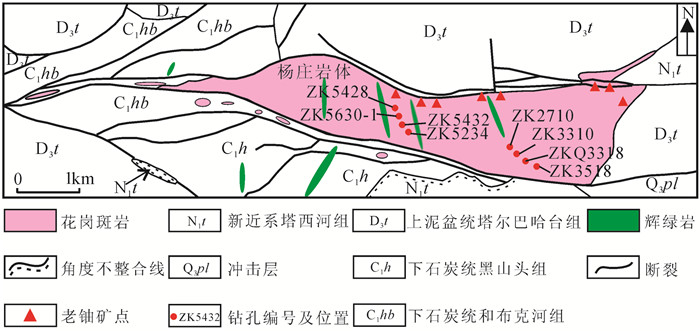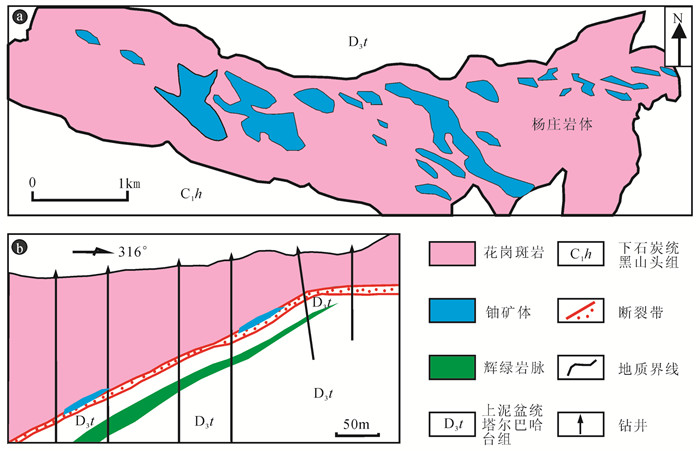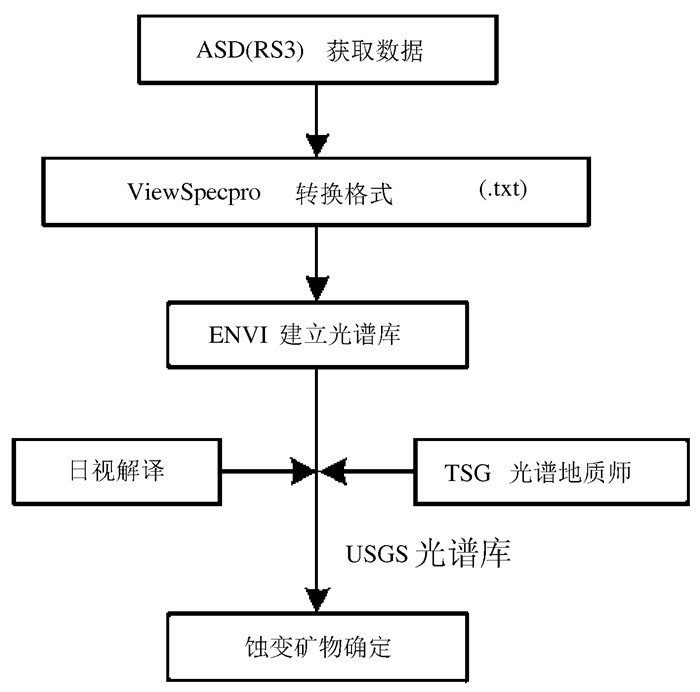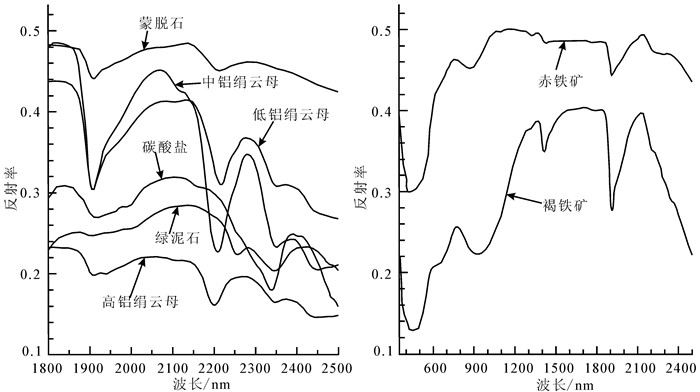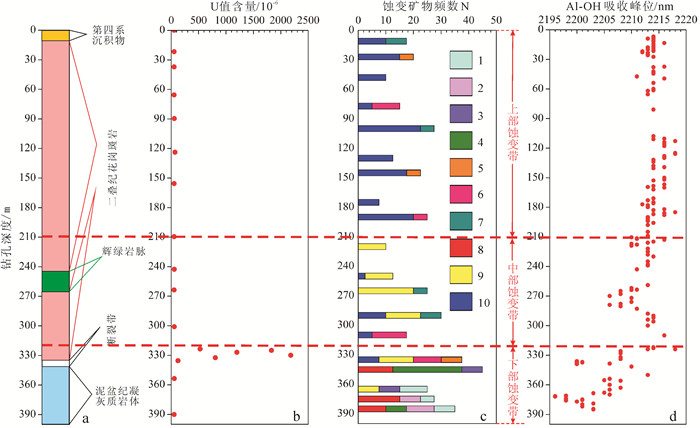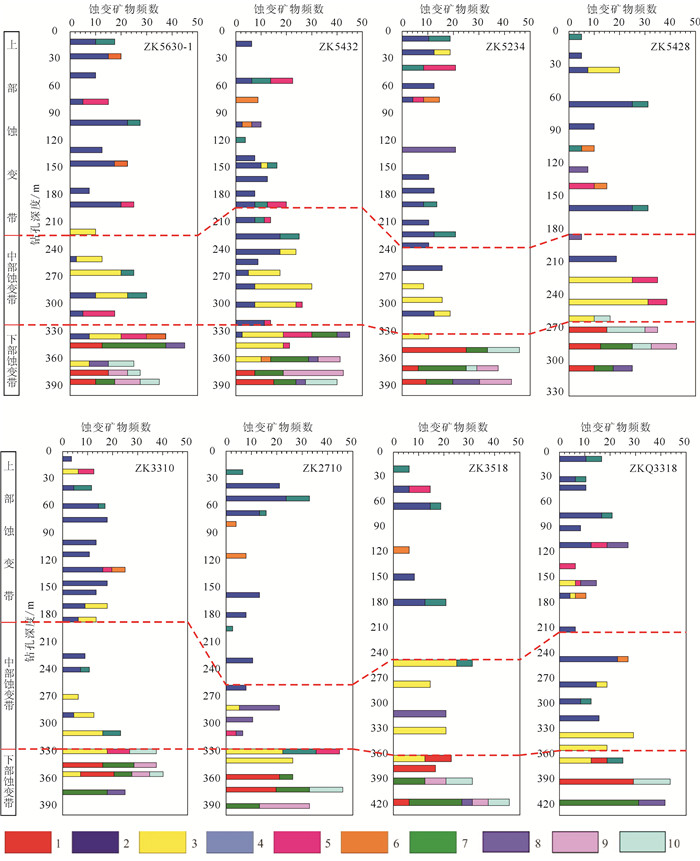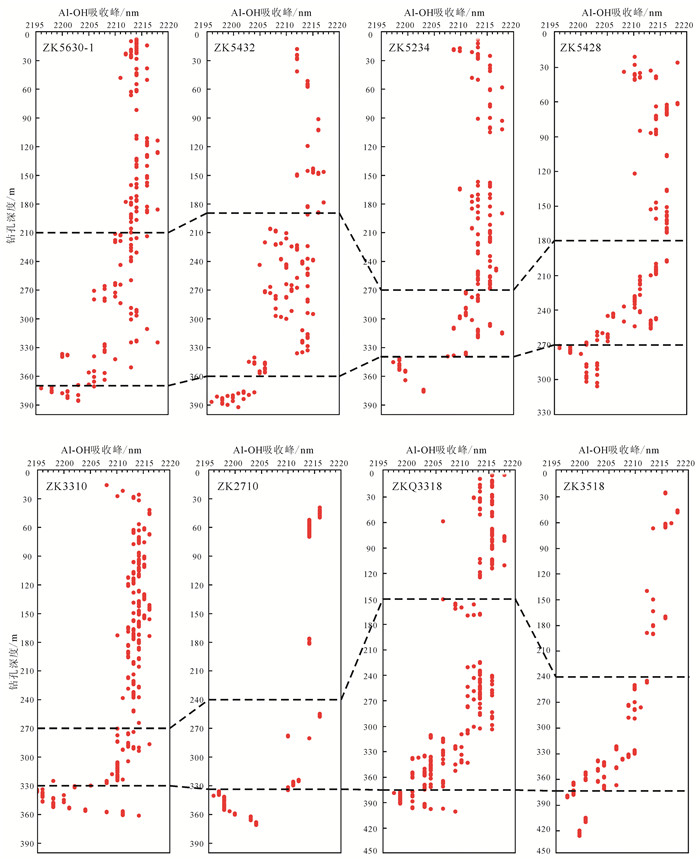Alteration zonation of drilling cores in the Baiyanghe uranium deposit of Xinjiang and its geological implications
-
摘要:
钻孔岩芯高光谱技术是获取岩芯地学信息与研究的新方向。新疆白杨河铀矿床钻孔岩芯蚀变发育,对其开展蚀变研究有助于对白杨河矿床深部铀矿勘探提出更好的找矿认识。本次研究利用FieldSpec4可见光-短波红外地面非成像光谱仪对新疆白杨河铀矿床8个钻孔进行光谱测试与分析,研究发现钻孔岩芯热液蚀变矿物组合垂向上具有明显的"上低下高中过渡"的三分带特征:即上部为低铝绢云母+少量赤铁矿与少量褐铁矿+少量蒙脱石,中部为中铝绢云母+低铝绢云母+少量蒙脱石+少量碳酸盐、赤铁矿与褐铁矿,下部为高铝绢云母+绿泥石+碳酸盐;绢云母Al-OH吸收峰位置变化规律反映出矿床的热液活动具有深部相对高温、高压、偏酸性,浅部相对低温、低压、偏碱性的特征。蚀变三分带特征以及热液活动特征表明白杨河铀矿床具有明显的热液成矿背景,同时,铀矿化总体处于3分带特征中的中部以中铝绢云母为主的蚀变带与下部以高铝绢云母为主的蚀变带之间的过渡带中,该过渡带是铀成矿的有利部位,同时也是可能的热液/矿化中心;过渡带中发育赤铁矿,中铝绢云母和高铝绢云母,此3种蚀变矿物可能与铀成矿关系密切。这些可以为白杨河铀矿床深部铀矿勘探提供借鉴与参考。
Abstract:Hyperspectral technology of drilling cores, which can provide geological information of drilling core, is a new research direction. Alteration of drilling cores is developed in the Baiyanghe uranium deposit, and the study of alteration can provide better reference for deep uranium exploration. In this paper, the spectra of eight drilling cores in the Baiyanghe deposit were measured and analyzed by FieldSpec4 visible-shortwave ground-based infrared spectrometer, and the results show that the hydrothermal alteration mineral assemblage of the drilling cores has three types of obvious zonation features, which is named "the upper is high, the bottom is low and the middle is transitional", In detail, Al-poor muscovite + a little hematite, limonite and montmorillonite assemblage is in the upper part of the drilling core, intermediate Al-content muscovite + Al-poor muscovite + a little hematite, limonite, montmorillonite and carbonate assemblage is in the middle, Al-rich muscovite + chlorite and carbonate assemblage is at the bottom. The varieties of muscovitès Al-OH absorption peak reflect the hydrothermal activities of the deposit, whose feature is that the relatively higher temperature, higher pressure and more acidic hydrothermal fluid is in the depth, and things are just the opposite in the upper part. The characteristics of three types of zonation and hydrothermal activities show that the Baiyanghe uranium deposit probably has obvious hydrothermal ore-forming background and uranium mineralization is located in the transition zone, which may be a favorable site for uranium mineralization and possible hydrothermal/mineralization centers. The transition zone develops hematite, intermediate Al-content muscovite, and Al-rich muscovite, which may be closely related to uranium mineralization. These data can provide reference and information for the deeper exploration.
-

-
图 2 白杨河铀矿床地质简图(据张鑫等修改, 2013)
Figure 2.
表 1 8种蚀变矿物特征吸收峰位
Table 1. The absorption features of eight kinds of altered minerals

-
Anthony E, Williams J, Iain M, Samson, Gema R, Olivo. 2000. The Genesis of hydrothermal fluorite-REE deposits in the Gallinas Mountains, New Mexico[J]. Economic Geology, 95(2000):327-342. http://cn.bing.com/academic/profile?id=bba2d4b729a6c74da39de898b7ebc5fa&encoded=0&v=paper_preview&mkt=zh-cn
Carsten L. 2011. Short Wave Infrared Functional Groups of Rock forming Minerals[J]. CSIRO Earth Science and Resource Engineering, Kensington, 1-14.
Dai Jingjing, Wang Ruijiang, Qu Xiaobo, Xin Hongbo. 2013. Application of TerraSpec spectrometer to the study of alteration information in the Duobuza porphyry copper deposit of Tibet[J]. Remote Sensing for Land and Resources, 25(1):105-109 (in Chinese with English abstract). http://cn.bing.com/academic/profile?id=66da82f0721f3fe30ce64286920bc545&encoded=0&v=paper_preview&mkt=zh-cn
Dong Lianhui, Feng Jing, Liu Dequan, Tang Yanling, Qu Xun, Wang Kezhuo, Yang Zaifeng. 2010. Research for Classification of Metallogenic Unit of Xinjiang[J]. Xinjiang Geology, 28(1):1-15(in Chinese with English abstract). http://cn.bing.com/academic/profile?id=37c372ec16fd1460edd2f92fcf2fc399&encoded=0&v=paper_preview&mkt=zh-cn
Dong Lianhui, Wang Kezhuo, Zhu Zhixin, Zhao Tongyang, Xu Shiqi, Zheng Jiaxing. 2013. The relationship between the characteristics of the large-scale deformation structure and the metallogenic processes in Xinjiang[J]. Geology in China, 40(5):1552-1568 (in Chinese with English abstract). http://cn.bing.com/academic/profile?id=c550e17beabe5212a5b90a037503b8d9&encoded=0&v=paper_preview&mkt=zh-cn
Du Xiaodi, Tang Yue, Liu Dechang, Li Zhao, Wang Haida. 2015. The application of aerial hyperspectral technology to the geological survey for oil and gas in the East Junggar Basin[J]. Geology in China, 42(1):275-287 (in Chinese with English abstract). http://cn.bing.com/academic/profile?id=83d5b38951485e96277244fc3cd55468&encoded=0&v=paper_preview&mkt=zh-cn
Duke E F, Lewis R D S. 2010. Near infrared spectra of white mica in the Belt Supergroup and implications for metamorphism[J]. American Mineralogist, 95(7):908-920. doi: 10.2138/am.2010.3281
Frank J A, van Ruitenbeek, Thomas J, Cudahy, Freek D van der Meer, Martin H. 2012. Characterization of the hydrothermal systems associated with Archean VMS-mineralization at Panorama, Western Australia, using hyperspectral, geochemical and geothermometric data[J]. Ore Geology Reviews, 33-46. http://cn.bing.com/academic/profile?id=90958bd40c0b91f59470d6860848d970&encoded=0&v=paper_preview&mkt=zh-cn
Guo Na, Guo Ke, Zhang Tingting, Liu Tinghan, Hu Bin, Wang Zhongwu. 2012. Hydrothermal alteration distribution model of the Jiama (Gyama) copper-polymetallic deposit based on shortwave technique[J]. Acta Geoscientica Sinca, 33(4):641-653 (in Chinese with English abstract). http://cn.bing.com/academic/profile?id=46c934e41e929b2bdb8d1ed6ef3a8f81&encoded=0&v=paper_preview&mkt=zh-cn
Herrmann W, Blake M, Doyle M, Huston D, Kamprad J, Merry N, Pontual S. 2001. Short wave length infrared (SWIR) spectral analysis of hydrothermal alteration zones associate with base metal sulfide deposits at Rosebery and Western Tharsis, Tasmania and Highway-Reward, Queensland[J]. Economic Geology, 74:1613-1629.
Kruse F A. 1994. Use of Airborne Imaging Spectrometer Data to Map Minerals Associated with Hydrothermally Altered Rocks in the Northern Grapevine Mountains, Nevada, and California[J]. Remote Sensing of Environment, 24:31-51. http://cn.bing.com/academic/profile?id=fd997c13bf3d68fe85ab2b6fb9eb00db&encoded=0&v=paper_preview&mkt=zh-cn
Liang Shuneng, Gan Fuping, Yan Bokun, Wang Runsheng, Yang Suming, Zhang Zhijun. 2012. Relationship between composition and spectral feature of muscovite[J]. Remote Sensing for Land and Resources, 94:111-115 (in Chinese with English abstract). http://cn.bing.com/academic/profile?id=972d6f866db6e35be464f406942ae6ce&encoded=0&v=paper_preview&mkt=zh-cn
Ma Xueping, Zong Jin, Zhang Meiqiong, Zhang Yubo, Lv Dan. 2015. Two new stratigraphic units of the Upper Devonian in the northwest border of the Junggar Basin, Xinjiang[J]. Geology in China, 42(2):695-709 (in Chinese with English abstract). http://cn.bing.com/academic/profile?id=49078028e6de7c4e979269a0878f066c&encoded=0&v=paper_preview&mkt=zh-cn
Sun Y Y, Seccombe P K, Yang K. 2001. Application of short-wave infrared spectroscopy to define alteration zones associated with the Elurazinc-lead-silver deposit, NSW, Australia[J]. Journal of Geochemical Exploration, 73:11-26. doi: 10.1016/S0375-6742(01)00167-4
Wang Mou, Li Xiaofeng, Wang Guo, Li Yanlong, Shi Zhilong, Lu Kegai. 2012. Geological characteristics of Baiyanghe BerylliumUranium deposits in Xuemisitan volcanic belt Xinjiang[J]. Mineral Exploration, 3(1):34-40 (in Chinese with English abstract).
Wang Mou, Li Xiaofeng, Wang Guo, Li Yanlong, Shi Zhilong, Lu Kegai. 2013. Analysis on the Controlling Factors of Uranium Polymetallic Metallogenic in the South of Xuemisitan Volcanic belt, Xinjiang[J]. Xinjiang Geology, 31(1):71-75 (in Chinese with English abstract). http://cn.bing.com/academic/profile?id=8e61a8c95c5aacb2b4e841c914773b41&encoded=0&v=paper_preview&mkt=zh-cn
Xu Q J, Liu S F, Ye F W, Zhang Z X, Zhang C. 2017. Application of CASI/SASI and fieldspec4 hyperspectral data in exploration of the Baiyanghe uranium deposit, Hebukesaier, Xinjiang, NW China[J]. International Journal of Remote Sensing, 39(2):453-469.
Xu Q J, Ye F W, Liu S F, Zhang Z X, Zhang C. 2017. Hyperspectral Alteration Information from Drill Cores and Deep Uranium Exploration in the Baiyanghe Uranium Deposit in the Xuemisitan Area, Xinjiang, China[J]. Remote Sensing, 9(5):1-21. http://cn.bing.com/academic/profile?id=389df1268c75c300b95f261a02d70d23&encoded=0&v=paper_preview&mkt=zh-cn
Yang K, Browne P R L, Huntington J F, Walshe J L. 2001. Characterising the hydrothermal alteration of the BroadlandsOhaaki geothermal system, New Zealand, using short-wave infrared spectroscopy[J]. Journal of Volcanology and Geothermal Research, 106:53-65. doi: 10.1016/S0377-0273(00)00264-X
Yang Zhiming, Hou Zengqian, Yang Zhusen, Qu Chunhuan, Li Zhenqing, Liu Yunfei. 2012. Application of short wavelength infrared (SWIR) technique in exploration of poorly eroded porphyry Cu district:A case study of Niancun ore district, Tibet[J]. Mineral Deposits, 31(4):699-717 (in Chinese with English abstract).
Ye Fawang, Meng Shu, Zhang Chuan, Xu Qingjun, Liu Hongcheng, Wu Ding. 2018. Minerageny study of high-Al, medium-Al and low-Al sericites identified by airborne hyperspectral remote sensing technology[J]. Acta Geologica Sinica, 92(2):395-412 (in Chinese with English abstract).
Yin Jiyuan, Chen Wen, Yu Shun, Long Xiaoping, Yuan Chao, Zhang Yan, Li Jie, Sun Jingbo, Liu Xinyu. 2013. Age, geochemical features and Cu-Au mineralization significance of the magnesian dioritic dykes in Baogutu area of west Junggar[J]. Geology in China, 40(4):1030-1043 (in Chinese with English abstract). http://cn.bing.com/academic/profile?id=28bd7f9fb79deb2da5104ae4ab171d33&encoded=0&v=paper_preview&mkt=zh-cn
Zhang Chuan, Ye Fawang, Xu Qingjun, Liu Hongcheng, Meng Shu. 2016. Mineral mapping and analysis of alteration characteristics using airborne hyperspectral remote sensing data in Baiyanghe uranium and Beryllium mine area, Xinjiang[J]. Remote Sensing for Land and Resources, 29(2):160-166 (in Chinese with English abstract).
Zhang Ge, Lian Yunchang, Wang Runsheng. 2005. Application of the portable infrared mineral analyser (PIMA) in mineral mapping in the Qulong copper prospect, Mozhugongka County, Tibet[J]. Geological Bulletin of China, 24(5):480-484 (in Chinese with English abstract). http://cn.bing.com/academic/profile?id=b4ea28182c9b5f6503287ceef0afb7d0&encoded=0&v=paper_preview&mkt=zh-cn
Zhang Jielin, Huang Yanju, Wang Junhu, Zhou Mi, Wu Ding, Xuan Yanxiu. 2013. Hyperspectral Drilling Core Logging and 3D Mineral Mapping Technology for Uranium Exploration[J]. Uranium Geology, 29(4):249-255 (in Chinese with English abstract). http://cn.bing.com/academic/profile?id=6fc70a5fb5132b2f8fd9edbdffcaccc4&encoded=0&v=paper_preview&mkt=zh-cn
Zhang Xin, Zhang Hui. 2013. Geochemical characteristics of the oreforming fluid and ore genesis of the Baiyanghe Be-U deposit, Xinjiang, China[J]. Geochimica, 42(2):143-152 (in Chinese with English abstract).
Zhao Liqing, Deng Jun, Yan Haitao, Li Xiaoying. 2008. Short Wavelength Infrared Spectral analysis of alteration zone in the Taishan gold deposit[J]. Geology and Prospecting, 44(5):58-62(in Chinese with English abstract).
董连慧, 冯京, 刘德权, 唐延龄, 屈迅, 王克卓, 杨在峰. 2010.新疆成矿单元划分方案研究[J].新疆地质, 28(1):1-15. http://d.old.wanfangdata.com.cn/Periodical/xjdz201001001
董连慧, 王克卓, 朱志新, 赵同阳, 郑加行, 徐仕琪. 2013.新疆大型变形构造特征与成矿关系研究[J].中国地质, 40(5):1552-1568. http://geochina.cgs.gov.cn/ch/reader/view_abstract.aspx?file_no=20130520&flag=1
代晶晶, 王瑞江, 曲晓明, 辛晓波.2013. TerraSpec波谱仪在西藏多不杂斑岩铜矿区蚀变信息研究中的应用[J].国土资源遥感, 25(1):105-109. doi: 10.6046/gtzyyg.2013.01.19
杜小弟, 唐跃, 刘德长, 李昭, 王海达. 2015.航空高光谱探测技术在准噶尔盆地东部地区油气调查中的应用[J].中国地质, 42(1):275-287. http://geochina.cgs.gov.cn/ch/reader/view_abstract.aspx?file_no=20150121&flag=1
郭娜, 郭科, 张婷婷, 刘廷晗, 胡斌, 王重午. 2012.基于短波红外勘查技术的西藏甲玛铜多金属矿热液蚀变矿物分布模型研究[J].地球学报, 33(4):641-653. http://kns.cnki.net/KCMS/detail/detail.aspx?filename=dqxb201204031&dbname=CJFD&dbcode=CJFQ
梁树能, 甘甫平, 闫柏锟, 王润生, 杨苏明, 张志军. 2012.白云母矿物成分与光谱特征的关系研究[J].国土资源遥感, 94:111-115. http://d.old.wanfangdata.com.cn/Periodical/gtzyyg201203020
马学平, 宗晋, 张美琼, 张宇波, 吕丹. 2015.新疆准噶尔盆地西北缘上泥盆统两个新地层单元[J].中国地质, 42(2):695-709. http://geochina.cgs.gov.cn/ch/reader/view_abstract.aspx?file_no=20150227&flag=1
王谋, 李晓峰, 王果, 李彦龙, 师志龙, 鲁克改. 2012.新疆雪米斯坦火山岩带白杨河铍铀矿床地质特征[J].矿产勘查, 3(1):34-40. http://d.old.wanfangdata.com.cn/Periodical/ytgcj201201009
王谋, 李晓峰, 王果, 李彦龙, 师志龙, 鲁克改. 2013.新疆雪米斯坦火山岩带南翼铀多金属成矿控制因素分析[J].新疆地质, 31(1):71-75. http://d.old.wanfangdata.com.cn/Periodical/xjdz201301016
杨志明, 候增谦, 杨竹森, 曲焕春, 李振清, 刘云飞. 2012.短波红外光谱技术在浅剥蚀斑岩铜矿区勘查中的应用——以西藏念村矿区为例[J].矿床地质, 31(4):699-717. http://d.old.wanfangdata.com.cn/Periodical/kcdz201204004
叶发旺, 孟树, 张川, 徐清俊, 刘洪成, 武鼎. 2018.航空高光谱识别的高、中、低铝绢云母矿物成因学研究[J].地质学报, 92(2):395-412. http://d.old.wanfangdata.com.cn/Periodical/dizhixb201802013
尹继元, 陈文, 喻顺, 龙晓平, 袁超, 张彦, 李洁, 孙敬博, 刘新宇. 2013.西准噶尔包古图富镁闪长质岩墙的时代、地球化学特征以及铜金成矿意义[J].中国地质, 40(4):1030-1043. http://geochina.cgs.gov.cn/ch/reader/view_abstract.aspx?file_no=20130404&flag=1
张川, 叶发旺, 徐清俊, 刘洪成, 孟树.2017.新疆白杨河铀铍矿区航空高光谱矿物填图及蚀变特征分析[J].国土资源遥感, 29(2):160-166. doi: 10.6046/gtzyyg.2017.02.23
章革, 连云长, 王润生. 2005.便携式短波红外矿物分析仪(PIMA)在西藏墨竹工卡县驱龙铜矿区矿物填图中的应用[J].地质通报, 24(5):480-484. http://d.old.wanfangdata.com.cn/Periodical/zgqydz200505015
张杰林, 黄艳菊, 王俊虎, 周觅, 武鼎, 宣言秀. 2013.铀矿勘查钻孔岩芯高光谱编录及三维矿物填图技术研究[J].铀矿地质, 29(4):249-255. http://kns.cnki.net/KCMS/detail/detail.aspx?filename=ykdz201304008&dbname=CJFD&dbcode=CJFQ
张鑫, 张辉. 2013.新疆白杨河大型铍铀矿床成矿流体特征及矿床成因初探[J].地球化学, 42(2):143-152. http://kns.cnki.net/KCMS/detail/detail.aspx?filename=dqhx201302005&dbname=CJFD&dbcode=CJFQ
赵利青, 邓军, 原海涛, 李晓英. 2008.台上金矿床蚀变带短波红外光谱研究[J].地质与勘探, 44(5):58-62. http://kns.cnki.net/KCMS/detail/detail.aspx?filename=dzkt200805012&dbname=CJFD&dbcode=CJFQ
-




 下载:
下载:
